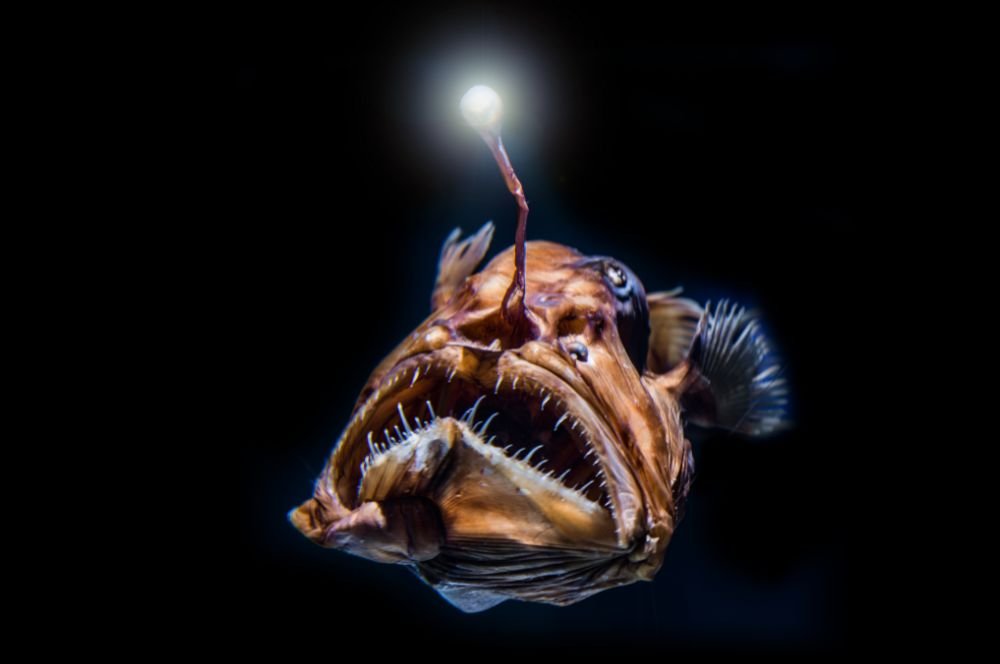The deep sea remains one of the most mysterious and unexplored regions of our planet. In this dark and high-pressure environment, deep-sea fish have evolved unique adaptations to survive. This article delves into the secret lives of these remarkable creatures, uncovering their fascinating adaptations and the mysteries that continue to intrigue scientists.

Deep-Sea Fish
Adaptations for Survival
- Bioluminescence Deep-sea fish often rely on bioluminescence, the ability to produce light through chemical reactions within their bodies. This adaptation serves multiple purposes, such as attracting prey, communicating with potential mates, and confusing predators. The anglerfish, for example, uses a bioluminescent lure to attract unsuspecting prey to its mouth.
- Enhanced Sensory Organs In the absence of sunlight, many deep-sea fish have developed highly sensitive eyes and other sensory organs to detect even the faintest light or movement. The barrel-eye fish, with its transparent head and upward-facing eyes, can spot prey silhouetted against the faint glow of the surface waters.
- Pressure Adaptations The immense pressure in the deep sea can crush most organisms. However, deep-sea fish possess flexible, gelatinous bodies and reduced skeletal structures to withstand these extreme conditions. Additionally, they have specialized enzymes and proteins that remain functional under high pressure.
Mysterious Behaviors
- Vertical Migration Some deep-sea fish engage in daily vertical migration, moving closer to the surface at night to feed and returning to the depths during the day. This behavior, known as diel vertical migration, helps them avoid predators and take advantage of the more abundant food sources near the surface.
- Symbiotic Relationships Certain deep-sea fish form symbiotic relationships with other marine organisms. For example, the flashlight fish harbors bioluminescent bacteria in special light organs. These bacteria provide the fish with light, aiding in navigation and communication, while the fish offers the bacteria a safe habitat.
- Reproductive Strategies Reproduction in the deep sea often involves unique strategies. Some species, like the anglerfish, exhibit extreme sexual dimorphism, with tiny males permanently attaching themselves to much larger females. This ensures that the male is always available to fertilize the female’s eggs. Thus a crucial adaptation in an environment where finding a mate can be challenging.
Precision and Passion in Every Adventure
At Radencich Salmon Flies, craftsmanship and attention to detail elevate every fishing experience. In a similar way, kingjohnnie Casino Login provides an online platform where precision, strategy, and excitement come together for a rewarding experience. Both pursuits celebrate skill, patience, and the thrill of success. Whether on the river or in the digital gaming world, dedication makes all the difference.
Ongoing Mysteries
- New Species Discovery The deep sea continues to reveal new species to scientists. Each expedition uncovers previously unknown fish with bizarre and intriguing characteristics. These discoveries expand our understanding of the diversity and adaptability of life in extreme environments.
- Unknown Diets While researchers have learned a great deal about deep-sea fish, many aspects of their diets remain a mystery. The scarcity of food at such depths forces these fish to employ unique feeding strategies, but the specifics of their diets and how they find food are still subjects of ongoing research.
- Behavioral Ecology The complex behaviors and interactions of deep-sea fish with their environment and other organisms are not fully understood. As technology advances, allowing for more detailed observations and studies, scientists continue to uncover the secrets of these enigmatic creatures.
Conclusion
In conclusion, the secret lives of deep-sea fish are a testament to the resilience and adaptability of life in extreme conditions. Through unique adaptations such as bioluminescence, enhanced sensory organs, and pressure-resistant bodies, these fish thrive in the dark, high-pressure depths of the ocean. Ongoing research and exploration promise to unveil even more mysteries. Hence enriching our understanding of these remarkable inhabitants of the deep sea.



